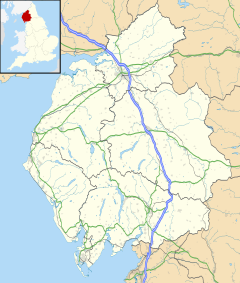Ravenglass
This article needs additional citations for verification. (October 2015) |
| Ravenglass | |
|---|---|
 View up Main Street | |
Location within Cumbria | |
| OS grid reference | SD0896 |
| Civil parish |
|
| District | |
| Shire county | |
| Region | |
| Country | England |
| Sovereign state | United Kingdom |
| Post town | Ravenglass |
| Postcode district | CA18 |
| Dialling code | 01229 |
| Police | Cumbria |
| Fire | Cumbria |
| Ambulance | North West |
| UK Parliament | |
Ravenglass is a small coastal village and natural harbour in Cumbria, England roughly halfway between Barrow-in-Furness and Whitehaven. Historically in Cumberland, it is the only coastal town in the Lake District National Park. It is located at the estuary of three rivers: the Esk, Mite and Irt.
The hamlet of Saltcoats lies north of the River Mite.
History

The town dates back to at least the 2nd century, when it was an important naval base for the Romans. The Latin name of the settlement is the subject of scholarly debate: believed by some experts to have been Tunnocellum,[1] it is often named Glannoventa. It occupied the most southerly point of the Cumbrian coastal defence system, which can be seen as an extension of Hadrian's Wall and the western extremity of the Roman frontier World Heritage Site.
Ravenglass was occupied by the Romans for over 300 years and had a garrison (castra) of 500 soldiers. The town was a regional supply point for much of north-western Roman Britain, with a road from Ravenglass over the Hardknott Pass to the Roman forts at Hardknott and Ambleside.[2] The location is featured in The Fort at River's Bend, a book in Jack Whyte's A Dream of Eagles (Camulod Chronicles) series, and is also mentioned briefly in Mary Stewart's Merlin trilogy under the name Clannoventa. Today, there are few Roman remains, with the notable exception of a bath-house, known locally as Walls Castle. This is one of the largest remaining Roman structures in England, originally covering an estimated area of 30 yards (27 m) by 13 yards (12 m) and with walls up to 12 feet (3.7 m) high, though only one end is now visible. Excavations of the rest of the foundations have since been covered and are not visible. The property is now maintained by English Heritage. Approximately a miles walk from the bath-house is Muncaster Castle which it is believed is built partly with the remains of a Roman Fort which once was located near Ravenglass.[2][3] The grade II listed Muncaster War Memorial, designed by Edwin Lutyens, sits between Muncaster and Ravensglass.[4]
Ravenglass is reputed as a birthplace of Saint Patrick along with Banwen in South Wales.
'Renglas' appears in charters and other records of the late 12th century. In 1208 King John granted Richard de Lucy, Earl of Egremont a charter for a market at Ravenglass on Saturdays and a yearly fair on the festival of St. James, 5 August.
Attractions
Tourist attractions include Muncaster Castle and the Ravenglass and Eskdale Railway.
Access
Ravenglass is served by Ravenglass railway station on the Cumbrian Coast railway line, with trains to Carlisle and Lancaster. This station is also a terminus of the narrow-gauge Ravenglass and Eskdale Railway, which runs inland up Eskdale. This serves both as a tourist attraction and as local transport during its operating season.
Ravenglass is connected by a minor road to the nearby A595 trunk road. It also has minor tracks running northwards and southwards via tidal fords, which are unsuitable for normal motor vehicles.
References
- ^ "RAVENGLASS (Itunocelum)". Retrieved February 26, 2013.
- ^ a b http://cambridgemilitaryhistory.com/2015/04/30/ruins-of-a-roman-bath-and-the-foundations-of-a-castle-ravenglass-and-muncaster/
- ^ http://www.bbc.co.uk/news/uk-england-cumbria-22277334
- ^ Historic England. "Muncaster War Memorial and area wall (1086636)". National Heritage List for England. Retrieved 7 September 2016.
External links
- Cumbria County History Trust: Muncaster (nb: provisional research only - see Talk page)
- Ravenglass Community website
- Muncaster Castle and Ravenglass Bath House article at www.cambridgemilitaryhistory.com

